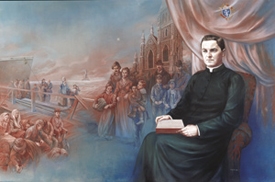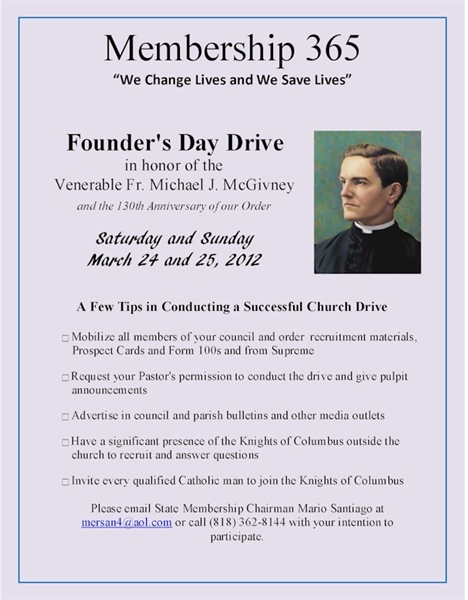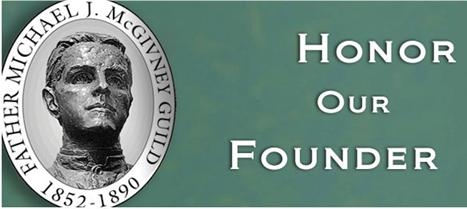Knights of Columbus Founders Day 2025 is on Saturday, March 29, 2025: Are the Knights of Columbus derived from the Knights Templar?
Saturday, March 29, 2025 is Knights of Columbus Founders Day 2025. Founder's Day Founder's Day

The Knights of Columbus was founded by a Catholic priest, Father Michael J. McGivney in New Haven, Connecticut on October 2, 1881, and incorporated under the laws of the U.S. state of Connecticut on March 29, 1882.[3] Though the first councils were all in that state, the Order spread throughout New England and the United States in the following years.
The primary motivation for the Order was to be a mutual benefit society. As a parish priest in an immigrant community, McGivney saw what could happen to a family when the breadwinner died and wanted to provide insurance to care for the widows and orphans left behind. He himself had to temporarily leave his seminary studies to care for his family when his father died.[4] In the late 19th century, Catholics were regularly excluded from labor unions and other organizations that provided social services. In addition, Catholics were either barred from many of the popular fraternal organizations, or, as in the case of Freemasonry, forbidden from joining by the Catholic Church itself. McGivney wished to provide them an alternative. He also believed that Catholicism and fraternalism were not incompatible and wished to found a society that would encourage men to be proud of their American-Catholic heritage.[5]
McGivney traveled to Boston to examine the Massachusetts Catholic Order of Foresters and to Brooklyn to learn about the recently established Catholic Benevolent League, both of which offered insurance benefits. He found the latter to be lacking the excitement he thought was needed if his organization were to compete with the secret societies of the day. He expressed an interest in establishing a New Haven Court of the Foresters, but the charter of Massachusetts Foresters prevented them from operating outside their Commonwealth. The committee of St. Mary's parishioners McGivney had assembled then decided to form a club that was entirely original.[6]
McGivney had originally conceived of the name "Sons of Columbus" but James T. Mullen, who would become the first Supreme Knight, successfully suggested that "Knights of Columbus" would better capture the ritualistic nature of the new organization.[7] The Order was founded 10 years before the 400th anniversary of Columbus' first visit to the New World and in a time of renewed interest in him. Columbus was a hero to many American Catholics and the naming him as patron was partly an attempt to build a bridge between the Irish-Catholic founders of the Order and the Catholic immigrants of other nationalities living in Connecticut.
The Knights of Columbus was founded in a time of increased interest in Christopher Columbus.The Connecticut Catholic ran an editorial in 1878 that illustrated how American Catholics esteemed Columbus. "As American Catholics we do not know of anyone who more deserves our grateful remembrance than the great and noble man - the pious, zealous, faithful Catholic, the enterprising navigator, and the large-hearted and generous sailor: Christopher Columbus."[8]
The name of Columbus was also partially intended as a mild ridicule of Anglo-Saxon Protestant leaders, who upheld the explorer (a Catholic Genovese Italian working for Catholic Spain) as an American hero, yet simultaneously sought to marginalize recent Catholic immigrants. In taking Columbus as their patron they were sending the message that not only could Catholics be full members of American society, but indeed they were instrumental in its foundation.
By the time of the first annual convention in 1884 the Order was prospering. In the five councils throughout Connecticut were 459 members and groups from other states were requesting information.[9] The Charter of 1899 included four statements of purpose, including "to promote such social and intellectual intercourse among its members as shall be desirable and proper, and by such lawful means as to them shall seem best."[10] The new charter showed members' desire to grow the organization beyond a simple mutual benefit insurance society.
The original insurance system devised by McGivney gave a deceased Knight's widow a $1,000 death benefit. Each member was assessed $1 upon a death and when the number of Knights grew beyond 1,000 the assessment decreased according to the rate of increase.[11] Each member, regardless of age, was assessed equally. As a result, younger, healthier members could expect to pay more over the course of their lifetimes than those men who joined when they were older.[12] There was also a Sick Benefit Deposit for members who fell ill and could not work. Each sick Knight was entitled to draw up to $5 a week for 13 weeks. If he remained sick after that the council to which he belonged regulated the sum of money given to him. At the time, $5 was nearly ⅔ of the pay a man in his 30s or 40s could expect to bring home each week.[13]
Today there are more than 14,000 councils around the world and the Knights of Columbus is a multi-billion dollar non-profit charitable organization. Knights may be seen distributing Tootsie Rolls to raise funds to fight developmental disabilities, volunteering for the Special Olympics and other charitable organizations, erecting pro-life billboards and "Keep Christ in Christmas" signs, conducting blood drives and raising funds for disaster victims, or parading at patriotic events with their bright capes, feathered chapeaux, and ceremonial swords. The cause for McGivney's canonization is currently before the Congregation for the Causes of Saints and a guild has been formed to promote his cause. If his cause is successful he will be the first American-born priest to be canonized as a Saint.
no i don't think so.the knights templar sort of evolved into free masonry.and free masons are not allowed specifically to join the knights of columbus.

does anyone have 3 reasons why Christopher Columbus deserves a holiday?
Its largely a matter of opinion, but we all learned about the exploits of Columbus in history, he is a central figure of all American history, both North and South. So, yes for that reason alone. Is there another man who is the subject of so many monuments in the Europe and the Americas?
We have come to see Columbus as a person of mixed character: heroic in taking the large risks of heading out to sea to prove his theory of worl geography, villainous in taking natives as prisoners to Spain, generous with his own life as a risk taker for God and Queen, selfish in his pursuit of gold, a man of faith who sought to bring Christianity to the pagans all the while recognizing himself as a sinner in many of his personal choices, among them adultery with a mistress who bore his second son.
The large men's organization , the Knights of Columbus, was instrumental in having this day set as a special remembrance to its honoree. It now numbers over 1.7 millioin members.
" The Order was founded 10 years before the 400th anniversary of Columbus' arrival in the New World and in a time of renewed interest in him. Columbus was a hero to many American Catholics, and the naming him as patron was partly an attempt to bridge the division between the Irish-Catholic founders of the Order and Catholic immigrants of other nationalities living in Connecticut.
The Connecticut Catholic ran an editorial in 1878 that illustrated the esteem in which American Catholics held Columbus. "As American Catholics we do not know of anyone who more deserves our grateful remembrance than the great and noble man - the pious, zealous, faithful Catholic, the enterprising navigator, and the large-hearted and generous sailor: Christopher Columbus."
The name of Columbus was also partially intended as a mild rebuke to Anglo-Saxon Protestant leaders, who upheld the explorer (a Catholic Genovese Italian working for Catholic Spain) as an American hero, yet simultaneously sought to marginalize recent Catholic immigrants. In taking Columbus as their patron, they were sending the message that not only could Catholics be full members of American society, but were, in fact, instrumental in its foundation."
Have a pleasant day.

the history of the "Pledge of Allegiance"?
Here's one!
The Pledge of Allegiance
A Short History
by Dr. John W. Baer
Copyright 1992 by Dr. John W. Baer
Francis Bellamy (1855 - 1931), a Baptist minister, wrote the original Pledge in August 1892. He was a Christian Socialist. In his Pledge, he is expressing the ideas of his first cousin, Edward Bellamy, author of the American socialist utopian novels, Looking Backward (1888) and Equality (1897).
Francis Bellamy in his sermons and lectures and Edward Bellamy in his novels and articles described in detail how the middle class could create a planned economy with political, social and economic equality for all. The government would run a peace time economy similar to our present military industrial complex.
The Pledge was published in the September 8th issue of The Youth's Companion, the leading family magazine and the Reader's Digest of its day. Its owner and editor, Daniel Ford, had hired Francis in 1891 as his assistant when Francis was pressured into leaving his baptist church in Boston because of his socialist sermons. As a member of his congregation, Ford had enjoyed Francis's sermons. Ford later founded the liberal and often controversial Ford Hall Forum, located in downtown Boston.
In 1892 Francis Bellamy was also a chairman of a committee of state superintendents of education in the National Education Association. As its chairman, he prepared the program for the public schools' quadricentennial celebration for Columbus Day in 1892. He structured this public school program around a flag raising ceremony and a flag salute - his 'Pledge of Allegiance.'
His original Pledge read as follows: 'I pledge allegiance to my Flag and (to*) the Republic for which it stands, one nation, indivisible, with liberty and justice for all.' He considered placing the word, 'equality,' in his Pledge, but knew that the state superintendents of education on his committee were against equality for women and African Americans. [ * 'to' added in October, 1892. ]
Dr. Mortimer Adler, American philosopher and last living founder of the Great Books program at Saint John's College, has analyzed these ideas in his book, The Six Great Ideas. He argues that the three great ideas of the American political tradition are 'equality, liberty and justice for all.' 'Justice' mediates between the often conflicting goals of 'liberty' and 'equality.'
In 1923 and 1924 the National Flag Conference, under the 'leadership of the American Legion and the Daughters of the American Revolution, changed the Pledge's words, 'my Flag,' to 'the Flag of the United States of America.' Bellamy disliked this change, but his protest was ignored.
In 1954, Congress after a campaign by the Knights of Columbus, added the words, 'under God,' to the Pledge. The Pledge was now both a patriotic oath and a public prayer.
Bellamy's granddaughter said he also would have resented this second change. He had been pressured into leaving his church in 1891 because of his socialist sermons. In his retirement in Florida, he stopped attending church because he disliked the racial bigotry he found there.
What follows is Bellamy's own account of some of the thoughts that went through his mind in August, 1892, as he picked the words of his Pledge:
It began as an intensive communing with salient points of our national history, from the Declaration of Independence onwards; with the makings of the Constitution...with the meaning of the Civil War; with the aspiration of the people...
The true reason for allegiance to the Flag is the 'republic for which it stands.' ...And what does that vast thing, the Republic mean? It is the concise political word for the Nation - the One Nation which the Civil War was fought to prove. To make that One Nation idea clear, we must specify that it is indivisible, as Webster and Lincoln used to repeat in their great speeches. And its future?
Just here arose the temptation of the historic slogan of the French Revolution which meant so much to Jefferson and his friends, 'Liberty, equality, fraternity.' No, that would be too fanciful, too many thousands of years off in realization. But we as a nation do stand square on the doctrine of liberty and justice for all...
If the Pledge's historical pattern repeats, its words will be modified during this decade. Below are two possible changes.
Some prolife advocates recite the following slightly revised Pledge: 'I pledge allegiance to the Flag of the United States of America and to the Republic for which it stands, one nation under God, indivisible, with liberty and justice for all, born and unborn.'
A few liberals recite a slightly revised version of Bellamy's original Pledge: 'I pledge allegiance to my Flag, and to the Republic for which it stands, one nation, indivisible, with equality, liberty and justice for all.'









